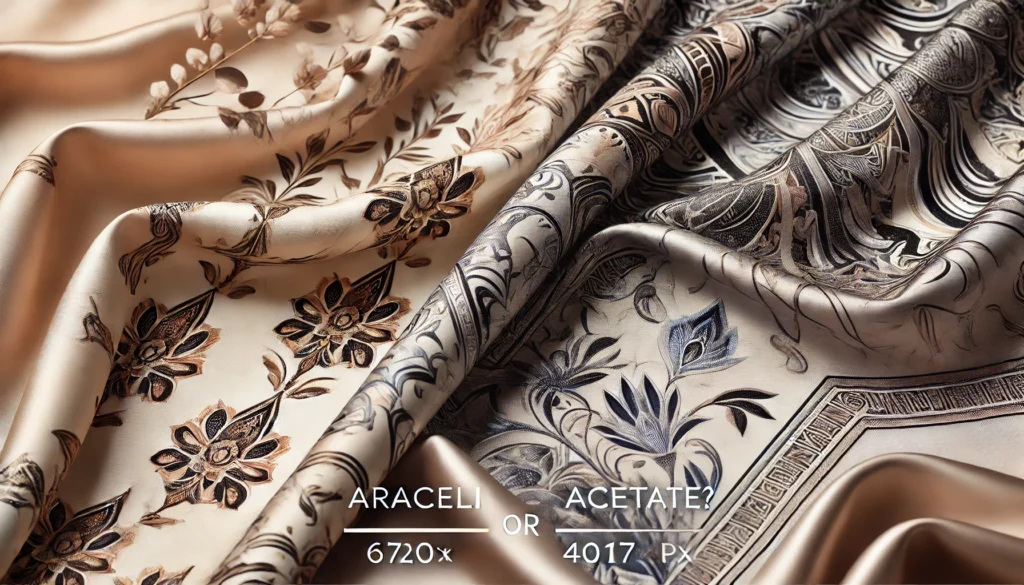
When choosing between araceli silk or acetat, understanding their unique properties is crucial. These fabrics cater to various needs, from luxurious apparel to budget-friendly alternatives. In this comprehensive guide, we’ll explore their characteristics, uses, and sustainability while helping you make the right choice.
What Is Araceli Silk?
Araceli silk is a luxurious natural fiber produced by silkworms. Known for its smooth texture and shimmering appearance, it has been a favorite in high-end fashion and home decor for centuries. Silk production is also eco-friendly, as it uses renewable resources.
Benefits of Araceli Silk
Luxurious Feel: Silk offers unmatched softness, providing a smooth and cool sensation against the skin.
Hypoallergenic: Ideal for individuals with sensitive skin or allergies.
Temperature Regulation: Keeps you cool in summer and warm in winter.
Eco-Friendly: As a natural fiber, silk is biodegradable and environmentally sustainable.
Drawbacks of Araceli Silk
High Cost: Due to its labor-intensive production, silk can be expensive.
Delicate Nature: Requires special care to maintain its sheen and durability.
Ethical Concerns: Involves silkworms, which may raise concerns for vegan or ethical consumers.
What Is Acetat?
Acetat, or acetate, is a semi-synthetic fabric made from cellulose derived from wood pulp. Created to mimic the look and feel of silk, it is a more affordable and versatile alternative, often used in fashion and interior design.
Benefits of Acetat
Affordable Alternative: Offers a luxurious appearance without the high price tag.
Vibrant Colors: Excellent dye retention results in vivid, long-lasting hues.
Lightweight: Perfect for breathable summer garments.
Wrinkle Resistance: Holds its shape better than silk under certain conditions.
Drawbacks of Acetat
Lower Durability: Prone to wear and tear, especially with frequent use.
Heat Sensitivity: Can get damaged when exposed to high temperatures.
Environmental Concerns: Its chemical treatment process makes it less sustainable than natural fibers.
Key Differences Between Araceli Silk and Acetat
Composition
- Araceli Silk: A natural protein fiber derived from silkworms.
- Acetat: A semi-synthetic fabric created from processed cellulose.
Appearance and Feel
- Araceli Silk: Offers a smooth, luxurious feel and natural sheen.
- Acetat: Mimics the look of silk but lacks its natural softness.
Breathability
- Araceli Silk: Highly breathable, making it comfortable in all seasons.
- Acetat: Less breathable, suitable for cooler climates.
Durability
- Araceli Silk: Long-lasting with proper care.
- Acetat: More prone to damage over time.
Cost
- Araceli Silk: Premium pricing reflects its quality and heritage.
- Acetat: Budget-friendly and accessible.
Historical and Cultural Significance of Araceli Silk

Silk has a rich legacy dating back to ancient China, where it was considered a symbol of wealth and luxury. It played a pivotal role in the Silk Road trade, connecting cultures through its high demand. Today, araceli silk is celebrated for its timeless elegance, making it a staple in both fashion and interior design.
Comparative Sustainability: Araceli Silk vs. Acetat
Environmental Impact of Araceli Silk
- Renewable and Biodegradable: Natural fibers decompose naturally, leaving minimal waste.
- Low Carbon Footprint: Uses fewer chemicals compared to synthetic fabrics.
Environmental Impact of Acetat
- Chemical Processing: Requires the use of acetone and other chemicals, which can affect the environment.
- Renewable Base: Derived from cellulose, but the processing offsets its eco-friendliness.
If sustainability is a priority, araceli silk may be the better choice despite its higher cost.
How to Identify Genuine Araceli Silk or Acetat
Tips for Spotting Genuine Araceli Silk:
- Touch: Feels smooth, cool, and luxurious.
- Appearance: Natural sheen that reflects light beautifully.
- Burn Test: Leaves ash and smells like burnt hair.
Tips for Spotting Acetat:
- Label: Look for “acetate” on the fabric tag.
- Feel: Lightweight with a slightly plastic-like finish.
- Heat Test: Acetat may wrinkle or melt under heat.
Versatility of Araceli Silk and Acetat Across Industries
Both fabrics serve diverse applications in fashion, decor, and crafts:
Uses of Araceli Silk
- Fashion: Evening gowns, wedding dresses, scarves, and luxury loungewear.
- Home Decor: Drapes, pillowcases, and bedding.
- Crafts: Hand-embroidered textiles and premium accessories.
Uses of Acetat
- Fashion: Linings for suits, casual blouses, and cocktail dresses.
- Costumes: Ideal for vibrant and eye-catching theatrical attire.
- Decor: Budget-friendly upholstery and decorative pieces.
Emerging Trends: Future Innovations in Silk and Acetat
As sustainability gains importance, manufacturers are exploring ways to make both fabrics more eco-friendly:
- Ethical Silk: Silk produced without harming silkworms is gaining traction.
- Recycled Acetat: Innovative methods are making acetate production more sustainable.
Cost vs. Value: Is Araceli Silk Worth the Investment?
Araceli silk offers unmatched luxury, comfort, and longevity, making it worth the investment for those who can afford it. Acetat, however, is a practical choice for budget-conscious consumers seeking an elegant appearance without compromising style.
Caring for Araceli Silk and Acetat
Araceli Silk Care
- Washing: Hand wash with mild detergent or dry clean.
- Drying: Lay flat away from sunlight.
- Ironing: Use a low-heat setting with a pressing cloth.
Acetat Care
- Washing: Machine washable on a gentle cycle.
- Drying: Avoid tumble drying; air dry instead.
- Ironing: Use low heat and avoid direct contact.
FAQs
1. Which is better: araceli silk or acetat?
It depends on your needs. Araceli silk is luxurious and durable, while acetat is affordable and low-maintenance.
2. Can acetat replace silk in all applications?
Not entirely. While it mimics silk’s appearance, it lacks its durability and breathability.
3. Is araceli silk eco-friendly?
Yes, it’s biodegradable and sustainable, but its production may raise ethical concerns.
4. How do I maintain araceli silk or acetat?
Araceli silk requires delicate care, while acetat is easier to maintain but sensitive to heat.
5. What are the cost differences between araceli silk and acetat?
Araceli silk is premium-priced, while acetat is a budget-friendly alternative.
Conclusion: Which Fabric Should You Choose?
The choice between araceli silk or acetat boils down to your priorities. For luxury, durability, and eco-friendliness, araceli silk is the winner. For affordability and versatility, acetat is an excellent alternative. By understanding their unique properties, you can make a choice that complements your needs and preferences.






